|
|
|
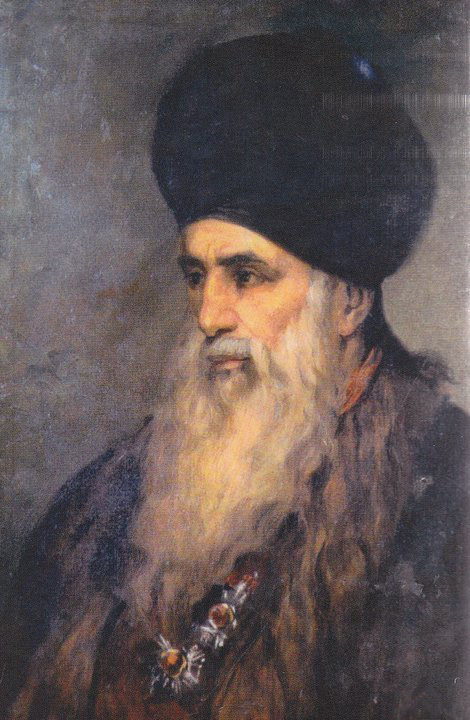 |
Moran Mor Ignatius Pathros (Peter)-IV, who led the Syrian Orthodox Church for 22 years as its supreme head (1872-'94), was the 116th in the line of canonical Patriarchs of Antioch in the Apostolic See of St. Peter. Little is known on the early life of this holy father, who is regarded as the architect of the modern Syrian Church.
Born in a well known Christian family of Turabdin in south east Turkey, he spent his child hood days at the Mor Hananyo Dayro (Deir al-Za`faran Monastery) which was the nave centre of the Syrian Church for many centuries. His priestly formation was at this monastery. In 1846 Patriarch Mor Elias II ordained Kassisso Pathros as the Metropolitan of Syria by name 'Mor Yulius'. As the diocesan Metropolitan he succeeded in settling the row with the Roman Catholic Church and recovered many of the ancient Monasteries and churches which were under dispute. It was during his stay at Constantinople, his immediate predecessor Patriarch Mor Yakub II passed away. Because of some difficulties to travel all the way to Mardin he informed the Synod his inability to attend the patriarchal election. But the Synod's unanimous decision was to elevate Mor Yulius as the next Patriarch which he politely refused to accept. However under continuous persuasion, he agreed to abide by the decision of the Holy Episcopal Synod.
At last on 16th June 1872, on the day of Pentecost, he was enthroned as the 116th Patriarch of Antioch at the ancient St. Mark's Dayro in Jerusalem. The Patriarch after his enthronement went to Amida (Omid / Dierbakir) and stayed there for a short period. The Dayro there was reconstructed under the advise of the Patriarch. In 1872 H.H ordained Rabban Abdul Sattuf as Metropolitan by name Mor Gregorios for the Archdiocese of Jerusalem and then left for Constantinople. Through the exertion of His Holiness, the Syrian Christians have received direct representation at Constantinople (recognition as an independent millet in Ottoman Turk) and was honored with other exclusive rights, thus fulfilling the long standing aspirations of the community.
|
St. Mark's Syrian Orthodox Monastery in Jerusalem where the holy father was enthroned as the 116th Patriarch of Antioch & All the East in 1872 |
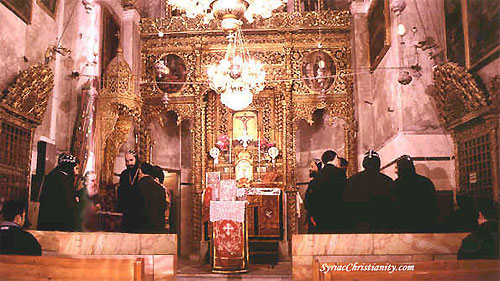 |
The Patriarchal visit to Malankara (Malabar)
It was during the Patriarch's stay at Constantinople, the letter from Pulikottil Mor Dionysius and Edavazikkal Philipose Kassisso from India reached the patriarchate seeking urgent help of the Holy father. Such was the trials and tribulation through which the church in Malabar (India) was passing through in that period. Problems created by Mor Athanasius who got ordained by Patriarch Yakub II but propagating the anti-Orthodox faith, was immense.
In response to the request, the Patriarch held discussions with his fellow Metropolitans and finally decided to travel to England to persuade the British Government on the issue pertaining the Syrian church in Malabar. His Holiness who was then 74 years of age, sailed from Constantinople in August 1874 after meeting the Sultan of Turkey and reached England a month later. Metropolitan Mor Gregorios Abdul Sattuf of Jerusalem accompanied the Patriarch in this tedious journey.
His Holiness first
met the British
government officials and presented the matter. The Patriarch also appealed to
the Secretary of State for India. The Archbishop of Canterbury at first assumed
a hostile attitude, saying he had been instructed by his Bishops in India that
Mor Athanasius deserved the support of the Church of England. But the British
Government were friendly to the Patriarch and asked the Madras Government to
consider his case as favourably as possible. He was also furnished with letters
of introduction.
During this visit Queen Victoria honoured the
Patriarch by giving him two successive audiences, on 21st and 28th February
1875.
His Holiness was
also decorated by Her Majesty.
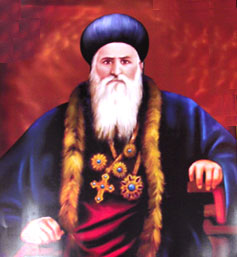 The English public seem to have been captivated
by his remarkable personality. His piety and profound knowledge of the Bible
made a deep impression wherever he went. It was recorded of his that he "knew
the Old and the New Testaments by heart," and that "his conversations were full
of allusions to and quotations from the Bible." Having
earned the respect and good wishes of all such Englishmen as were not amenable
to the influence of the C.M.S. missionaries in Travancore, the Patriarch set
sail to India.
(On this first visit of any Syrian Orthodox
Patriarch to England, in the winter of 1874-75, Mor Peter IV took the
opportunity to have a printing press sent back to the Deir al-Za`faran
Monastery, and once it had been installed it was put to good use in the printing
of a number of liturgical and other books in Syriac.)
The English public seem to have been captivated
by his remarkable personality. His piety and profound knowledge of the Bible
made a deep impression wherever he went. It was recorded of his that he "knew
the Old and the New Testaments by heart," and that "his conversations were full
of allusions to and quotations from the Bible." Having
earned the respect and good wishes of all such Englishmen as were not amenable
to the influence of the C.M.S. missionaries in Travancore, the Patriarch set
sail to India.
(On this first visit of any Syrian Orthodox
Patriarch to England, in the winter of 1874-75, Mor Peter IV took the
opportunity to have a printing press sent back to the Deir al-Za`faran
Monastery, and once it had been installed it was put to good use in the printing
of a number of liturgical and other books in Syriac.)
In January 1875, the Metropolitan Mor Dionysius once again send a letter to the Patriarch in England requesting him to visit Malankara. On this repeated request, in April the Patriarch sailed to India via; Egypt and reached Bombay towards the end of May. Mor Dionysius met His Holiness the Patriarch, the supreme head of the Syrian Church and the Jerusalem Metropolitan Mor Gregorios, at Pune. From there they together travelled to Madras by train to meet the Governor. Only on reaching there, they came to know that Governor is then at Oottaccamand, his summer residence. So they travelled to the place but since there was no proper road after Mettupalyalam, His Holiness who was around 75 then and others, had to climb the hill for an whole day which was a very tedious voyage as explained in the biography of Pulikottil Mor Dionysius Metropolitan, published in 1901. At Oottaccamand His Holiness met the Governor and explained to him the grave situation of the Syrian Christians of Malabar. Impressed by the Patriarch's explanation the governor promised all the help needed for His Holiness and his church in Malabar. They were at Oottaccamand for 3 days and later left to Malabar by train and reached Kunnamkulam by the middle of June. His Holiness was given a rousing reception at the Arthat St. Mary's church where he celebrated the Pentecost day services. From there His Holiness went to Thiruvanathapuram, the capital of Travancore state and met the Maharaja. On the way to the state capital, His Holiness stayed at Cochin for 10 days; the Patriarch was given an unprecedented welcome by the enthusiastic faithful at all the places.
Soon after the Patriarch's arrival in Malabar (Malankara), the royal proclamation in favour of Mor Athanasius and the CMS missionaries were cancelled by the Travancore State Government. A fresh decree was issued little later, disavowing the Government's right thereafter to interfere in the appointment and dismissal of bishops in the Syrian Church and directing all parties to settle their disputes through the medium of the recognized Civil Courts of the State. The beneficent policy of religious toleration, which the Hindu rulers of Malabar had pursued towards their Syrian Christian subjects from the days of the Apostle St. Thomas down to the arrival of European missionaries, both Roman Catholic and Protestant, was thus re-established on the 4th of March 1876. This was a bitter disappointment to the C.M.S missionaries, who had hoped, by applying methods of coercion, to proselytize the whole body of Syrian Christians. The enthusiasm created among the Syrians by the arrival of H.H. the Patriarch Peter IV knew no bounds. His Holiness was hailed as a deliverer. Even the bosom friends of Mor Athanasius deserted him when the Patriarch arrived in the country and the former Proclamation was cancelled.
|
The Marthoman Church at Mulanthuruthy in India where the Holy father consecrated Holy Myron and convened the historic Synod in 1876 |
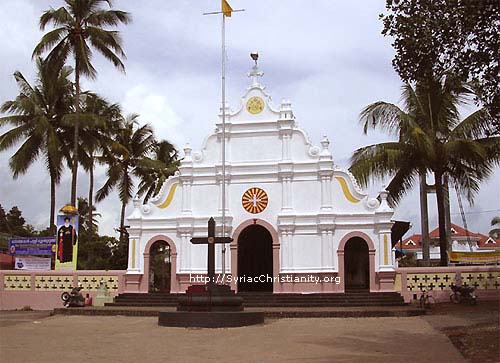 |
In July 1876 His Holiness held a General Synod of the community in the church at Mulanthuruthy for three consecutive days (popularly known as the first Mulanthuruthy Synod) and made various organizational and administrative arrangements. One of the main decisions of this historic Synod was the formation of a representative body for the Malankara Edavaka (Archdiocese) by name 'Malankara Jacobite Syrian Christian Association Committee', consisting of twenty-four elected members thus introducing a democratic set up of administration. The then Metropolitan of Malabar Mor Dionysius Pulikottil was given the new title of 'Malankara Metropolitan' and was appointed as the President of the Association by the Patriarch. It was also decided to divide the Malankara Archdiocese into six and ordain a Metropolitan for each, under the Malankara Metropolitan. Chathuruthy Geevarghese Ramban (St. Gregorios of Parumala), the private secretary of His Holiness during his stay in Malankara, was the chief coordinator of this Synod. Later when the Patriarch consecrated Holy Myron for the first time in India at the Mulanthuruthy church on 27 August, Chathuruthil Ramban again got the privilege to assist His Holiness. In the subsequent months His Holiness ordained six Metropolitans, one was Chathuruthy Ramban who was given the title Mor Gregorios (1848-1902), a great saint in whose name all the faithful in Malankara take pride and find solace.
Before the advent of the Patriarch, the Jacobite Church in the country seemed destined to disappear altogether. Yet, within the space of less than two years, he was able to rebuild the old edifice on stronger, broader and deeper foundations. Abuses of practice which had crept into the religious observances of the people, and of which they had shown themselves most tenacious in the past, were removed without any difficulty and without raising even a murmur of discontent or disapprobation from the people. Marriage was made compulsory in the case of candidates aspiring to ordination for parish work.
The Patriarch was a stranger to the customs of this country when he came here. He did not know a word of English. When he set out upon this memorable journey, he had not been aware of any human agency to guide and support him. And yet, single-handed, he overcome all obstacles. He had a volcanic presence which he achieved in the face of the well-night insurmountable difficulties that confronted him on every side, his was the greatest personality that ever crossed the stage of Syrian history within historic times.
H.H. Patriarch Ignatius Pathros IV (right) along with
Mor Gregorios Abded' Aloho (later Patriarch Ignatius Abdulla II) & Archbishop of Canterbury
(Source: http://suryoyenews.com/)
|
|
Patriarch returns from Malankara
After two years of successful labours for defending the sanctity of faith and for establishing a democratic pattern of administration of the Malankara Archdiocese, the Holy father embarked from Bombay for Jerusalem in May 1877. On his way back H.H. visited the Syrian churches in Egypt. Finally he reached Constantinople where he established a new church in the name of the Mother of God. While residing there, Ramban Elias who later became the Patriarch of Antioch and the all the East (St. Ignatius Elias III) stayed with him for a while. Later the Patriarch left for Mor Hananyo Dayro where he consecrated Holy Myron again. The holy father spend the remaining years in this monastery.
At 4.00 am on Monday, October 8, 1894, Moran Mor Ignatius Pathros IV passed away. He was then about 96. The mortal remains of the holy Patriarch were interred at the Mor Hananyo (St. Ananias) Dayro, which is also known as the Kurkkuma Dayro or Deir al-Za`faran Monastery. (This ancient monastery is situated today in south east Turkey).
|
Monastery of Mor Hananyo (St. Ananias) where the Patriarch's mortal remains were interred |
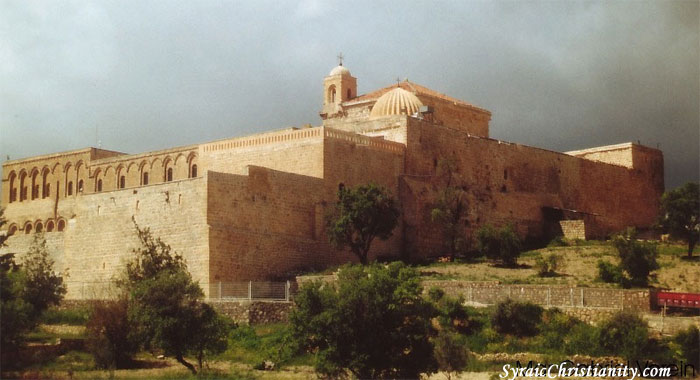 |
References:
|
1. Rev. Fr. (Dr) K M Rajan: Biography of church fathers (Malayalam), 2003 |
|
3. M P Varkey: "Malankara Edavakayute Mor Divanasios Metrapolita", 1901 |
|
5. Hollerweger Hans: “Living Cultural Heritage – TURABDIN”, 1999 |
|
6. Christine Chaillot: “The Syrian Orthodox Church of Antioch and all the East”, 1998 |